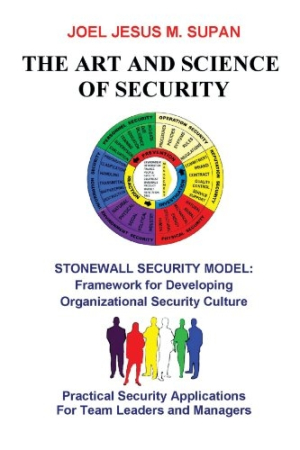The Art and Science of Security
Practical Security Applications for Team Leaders and Managers
There is no question that security has become a primary need for businesses in light of continuing concern about terrorism and acts of violence, as well as accidental and natural disasters. Given this reality, Joel Jesus M. Supan’s The Art and Science of Security: Practical Security Applications for Team Leaders and Managers, which looks at security in the broadest sense of the word, should be of compelling interest to business leaders.
Supan provides a comprehensive first section called “Fundamentals of Security.” It covers basic resources, hazards and threats, security risks, security needs of an organization, and principles of security. It is a useful primer for those who may be less familiar with basic security concepts. In discussing security principles, Supan makes two key statements: “There is no absolute security,” and “Security is only as good as its weakest link.” These statements help put the remainder of the book into context.
In the next section, the author offers an instructional overview of the various security areas of concern to any business: personnel security, information security, operations security, physical security, environmental security, and reputation security. For each security area, Supan offers a compact, well-written chapter that defines the topic, the security objective, and the elements that should be included in a security plan. In the chapter regarding operations security, for example, Supan discusses maintaining the security of policies, procedures, systems, and rules and regulations. He notes that there are three “requisites” needed for operations security: education, engineering, and enforcement. He then details various “best practices” for operations security.
The third section of the book presents an extended discussion of a “guard system,” including basic functions, methods for performing the functions, and security guard force management. In addition to providing a lot of detail, the author includes Appendices to this section with numerous helpful forms, such as “Security Patrol Checklist,” “Unusual Incident Report Checklist,” and “Security Operations Report.” These can be used by businesses with little modification.
The final section of the book explores ways to apply security to organizational needs, such as the development of a corporate security program, conducting a security assessment, creating a security plan, emergency planning, and security investigation. Supan concludes with “The Stonewall Security Model,” which sums up the material and offers a road map for putting a security program in place.
Supan does a fine job of covering each and every aspect of security with just enough detail. The book is well-organized, written in simple language, and broken into easily digestible pieces of information.
Any business leader responsible for his or her company’s security is sure to find The Art and Science of Security to be an invaluable resource. Middle managers, too, would benefit from exposure to this authoritative discussion of hazards and threats and how to be prepared to face them. In today’s world, knowledge of security issues and tools is a necessity for everyone.
Reviewed by
Barry Silverstein
Disclosure: This article is not an endorsement, but a review. The publisher of this book provided free copies of the book and paid a small fee to have their book reviewed by a professional reviewer. Foreword Reviews and Clarion Reviews make no guarantee that the publisher will receive a positive review. Foreword Magazine, Inc. is disclosing this in accordance with the Federal Trade Commission’s 16 CFR, Part 255.

